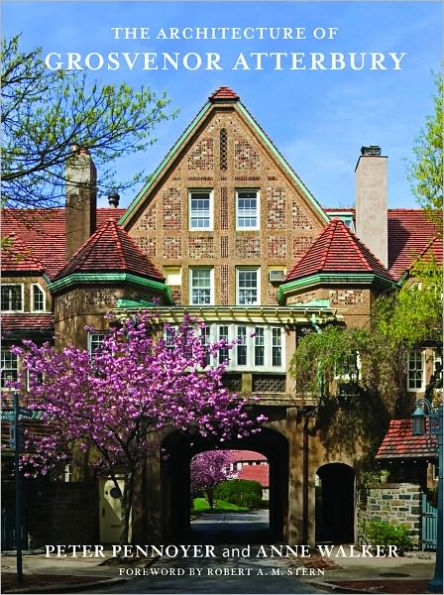The Architecture of Grosvenor Atterbury
The first close look at an innovative architect and inventor who held that traditional styles could be successfully adapted for modern times. In the final decade of the nineteenth century and the early twentieth century, the United States experienced exponential growth and a flourishing economy, and with it, a building boom. Grosvenor Atterbury (1869–1956) produced more than one hundred major projects, including an array of grand mansions, picturesque estates, informal summer cottages, and farm groups. However, it was his role as town planner and civic leader and his work to create model tenements, hospitals, workers’ housing, and town plans for which he is most celebrated. His Forest Hills Gardens, designed in association with the Olmsted Brothers, is lauded as one of the most highly significant community planning projects of its time.
As an inventor, Atterbury was responsible for one of the country’s first low-cost, prefabricated concrete construction systems, introducing beauty and inexpensive good design into the lives of the working classes. The Architecture of Grosvenor Atterbury is the first book to showcase the rich and varied repertoire of this prolific architect whose career spanned six decades and whose work affected the course of American architecture, planning, and construction. Illustrated with Jonathan Wallen’s stunning color photographs and over 250 historic drawings, plans, and photographs, it also includes a catalogue raisonné and an employee roster. It is the definitive source on an architect who made an indelible imprint on the American landscape.
1100879415
As an inventor, Atterbury was responsible for one of the country’s first low-cost, prefabricated concrete construction systems, introducing beauty and inexpensive good design into the lives of the working classes. The Architecture of Grosvenor Atterbury is the first book to showcase the rich and varied repertoire of this prolific architect whose career spanned six decades and whose work affected the course of American architecture, planning, and construction. Illustrated with Jonathan Wallen’s stunning color photographs and over 250 historic drawings, plans, and photographs, it also includes a catalogue raisonné and an employee roster. It is the definitive source on an architect who made an indelible imprint on the American landscape.
The Architecture of Grosvenor Atterbury
The first close look at an innovative architect and inventor who held that traditional styles could be successfully adapted for modern times. In the final decade of the nineteenth century and the early twentieth century, the United States experienced exponential growth and a flourishing economy, and with it, a building boom. Grosvenor Atterbury (1869–1956) produced more than one hundred major projects, including an array of grand mansions, picturesque estates, informal summer cottages, and farm groups. However, it was his role as town planner and civic leader and his work to create model tenements, hospitals, workers’ housing, and town plans for which he is most celebrated. His Forest Hills Gardens, designed in association with the Olmsted Brothers, is lauded as one of the most highly significant community planning projects of its time.
As an inventor, Atterbury was responsible for one of the country’s first low-cost, prefabricated concrete construction systems, introducing beauty and inexpensive good design into the lives of the working classes. The Architecture of Grosvenor Atterbury is the first book to showcase the rich and varied repertoire of this prolific architect whose career spanned six decades and whose work affected the course of American architecture, planning, and construction. Illustrated with Jonathan Wallen’s stunning color photographs and over 250 historic drawings, plans, and photographs, it also includes a catalogue raisonné and an employee roster. It is the definitive source on an architect who made an indelible imprint on the American landscape.
As an inventor, Atterbury was responsible for one of the country’s first low-cost, prefabricated concrete construction systems, introducing beauty and inexpensive good design into the lives of the working classes. The Architecture of Grosvenor Atterbury is the first book to showcase the rich and varied repertoire of this prolific architect whose career spanned six decades and whose work affected the course of American architecture, planning, and construction. Illustrated with Jonathan Wallen’s stunning color photographs and over 250 historic drawings, plans, and photographs, it also includes a catalogue raisonné and an employee roster. It is the definitive source on an architect who made an indelible imprint on the American landscape.
75.0
In Stock
5
1

The Architecture of Grosvenor Atterbury
288
The Architecture of Grosvenor Atterbury
288Hardcover
$75.00
75.0
In Stock

Product Details
| ISBN-13: | 9780393732221 |
|---|---|
| Publisher: | Norton, W. W. & Company, Inc. |
| Publication date: | 08/31/2009 |
| Pages: | 288 |
| Sales rank: | 976,487 |
| Product dimensions: | 9.10(w) x 12.10(h) x 1.10(d) |
About the Author
From the B&N Reads Blog
